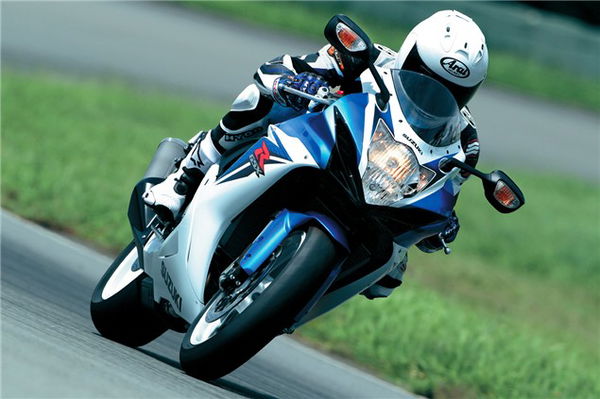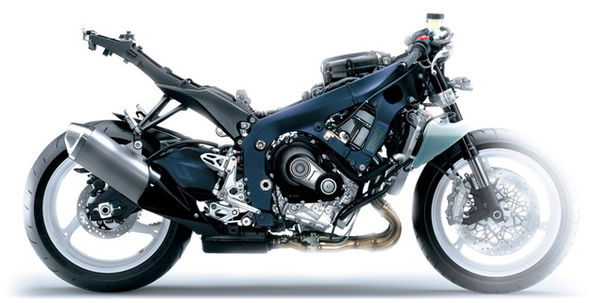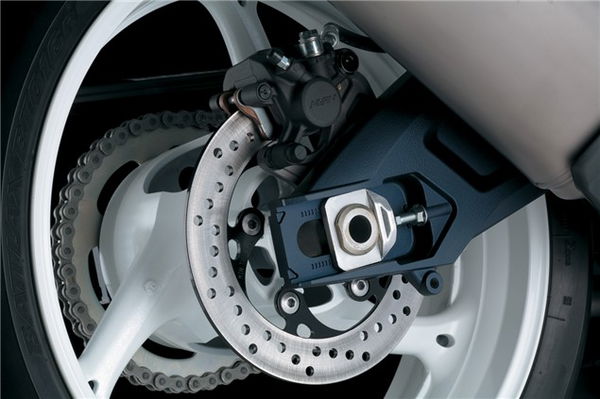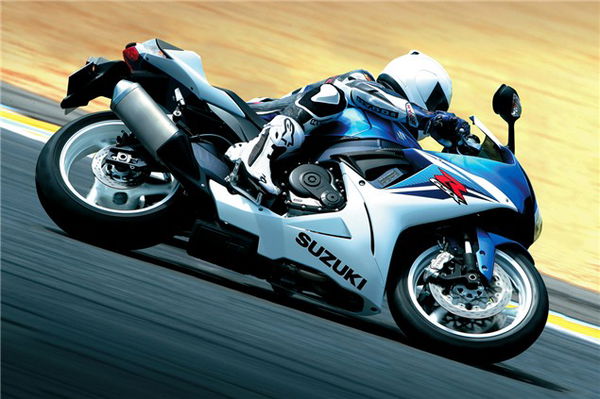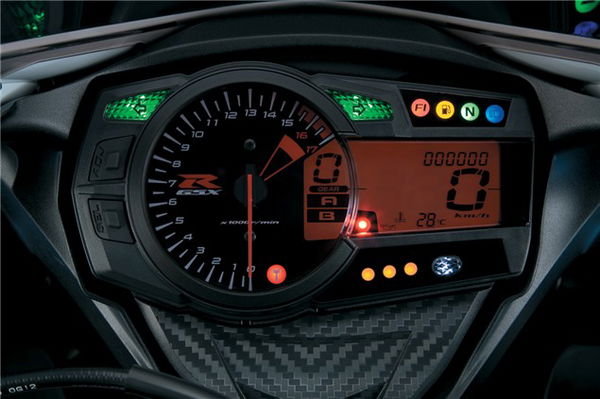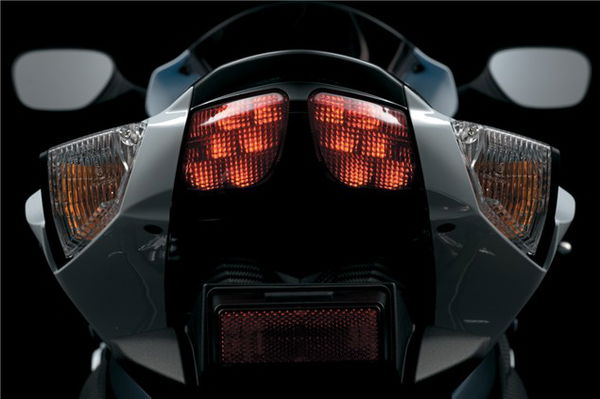2011 Suzuki GSX-R600 Tech Spec
Complete technical specifications and details for the new Suzuki GSX-R600
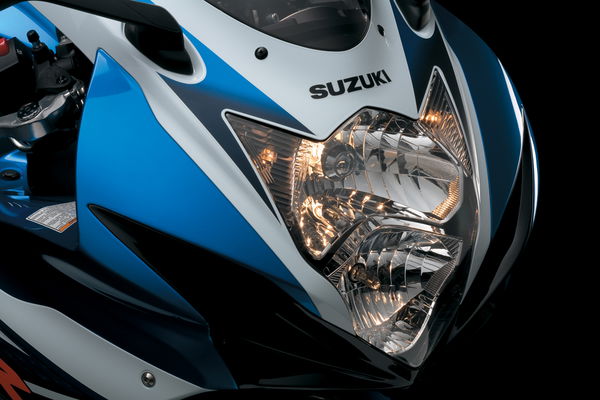

Introduction
Staying loyal to the brand concept ‘The Top Performer’, we are always trying to achieve a top class performance with a mixture of the three key elements of Supersport motorcycles - engine performance, cornering performance, and brake performance.
Our solution to ultimately scale up all those performances was to drastically trim down the weight.
In comparison to the current model, we have reduced the weight of the new 2011 GSX-R600 by as much as 9 kilograms. This remarkable weight reduction was achieved not only by using one big block of metal, but rather by the dedicated effort of our engineers to review and optimize the rigidity balance of each and every small piece of the machine.
In addition to the weight reduction, the analytical MotoGP technology enabled us to reduce internal mechanical losses and this resulted in stronger acceleration and low-to-mid rpm range torque.
At the same time, the fuel consumption has improved by approximately 10% in comparison to the current model, measured in WMTC mode, Suzuki in-house research.
Also we have made no compromises in our careful selection of the equipment. This model is fitted with race-proven parts such as Big Piston Front-forks and Brembo front brake calipers.
As a result of achieving remarkable weight reductions and further improved engine efficiency, this new GSX-R600 now has superb cornering and brake performance and enjoyable acceleration, as well as improved environmental performance.
Please enjoy the exciting evolution of its overall performance, the evolution of ‘The Top Performer’.
��
1. Product Concept
(1) The Top Performer
A lightweight chassis featuring a compact wheelbase and race-developed suspension. A compact, powerful 4-cylinder engine delivering a real-world demonstration of advanced race-proven technology. The GSX-R600 – designed to be The Top Performer in its class, a total package designed to Own The Racetrack.
(2) Class-leading performance and improved environmental performance
Compared to the current model, the latest GSX-R600 has a 9 kilograms lighter curb mass, 15mm shorter wheelbase and reduced (by 55mm front and 35mm rear) overhang, as well as approximately 10% better fuel mileage (WMTC mode, Suzuki in-house research) and lower emissions.
We have mainly reduced the weight of the following parts such as exterior components, chassis parts and muffler:
Parts | Weight Reduction |
Exterior resin parts | 3,400 g |
Muffler | 1,700 g |
Main frame | 1,350 g |
Front forks | 860 g |
Rear suspension system | 780 g |
Swingarm | 900 g |
Front brake calipers | 405 g |
Thanks to the 9 kilograms weight reduction and increased peak engine output, the GSX-R600 delivers a class-leading power-to-weight ratio.
(3) Attractive styling embodying the model’s class-leading running performance
The instantly recognizable GSX-R design with vertically stacked dual headlights, built-in turn signals and taillight is now lighter and more compact to deliver the best balance.
2. Key Features Overview
Feature map of the new GSX-R600
(1) Frame
The newly designed aluminum-alloy twin-spar frame features a lightweight and shorter-wheelbase design (15mm shorter compared to the current model).
(2) Front suspension
The Big Piston Front-fork (BPF) is a new design created with racing feedback. The BPF delivers stable damping performance even during hard braking, resulting in greater smoothness of fork action.
(3) Front brake calipers (Brembo)
The front brake calipers are changed to a one-piece monoblock design by Brembo. The brake system components were reviewed down to details to deliver stopping performance that’s not only powerful but also highly controllable with a superb feel.
(4) Engine
Changes to various moving parts reduce mechanical losses and enhance low-to-mid rpm range performance. The engine/chassis performance balance is as refined as ever, thanks to the lighter chassis. The overall engine performance potential is significantly upgraded.
(5) Suzuki Drive Mode Selector (S-DMS)
The new S-DMS allows the rider to select between two engine performance maps to suit the rider’s personal preferences in different riding situations.
(6) Muffler
The newly designed muffler is compact and 1,700 grams lighter as a whole.
(7) Rear combination lamps
Distinctive LED combination lamps are built into the tail section that’s slim-styled and thin-shaped.
(8) Headlights
The new model inherits the vertical dual headlights, long a GSX-R trademark. They are lighter by 562 grams.
(9) External components
By minimizing the external components, which weight is reduced by 3,400 grams, they contribute for better aerodynamics and wind protection.
(10) Instrument cluster
The instrument cluster is high functional type which is the same as that of the 2010 GSX-R1000. The engine rpm indicator which is installed in GP machine is adopted.
Chassis
1. Outline of chassis
Features
1. Chassis designed with emphasis on light weight and compactness
The new components were developed with priority on keeping the weight low.
2. The basic performance has been enhanced thanks to lighter chassis
Handling performance is enhanced with a 15mm-shorter wheelbase.
3. The suspension and the brake have been upgraded
Big Piston Front-fork (BPF) is adopted for the front suspension, similar to that on the 2010 GSX-R1000.
Front brakes newly use Brembo monoblock calipers.
Benefits
The lightweight, compact chassis realizes nimble handling.
The vehicle/rider mass is better centered by the shortened wheelbase and overall length. Reduction of inertial mass enhances handling performance.
(1) Frame
Features
New cast-aluminum twin-spar frame composed of five sections. The new frame is designed with emphasis on weight reduction.
Material thickness of each frame section has been carefully optimized (the thinnest section has been narrowed from 3.5mm to 3.0mm), resulting in frame weight reduced by 1,350 grams.
The seat rail is now narrower, making it easier for the rider to straddle the machine.
In order to further optimize chassis dimensions, the wheelbase has been shortened by reviewing the layout of the frame and other sections, while keeping the swingarm length the same as the current model.
(2) Front suspension
Features
The front suspension newly features inverted telescopic type Big Piston Front-forks (BPF) made by SHOWA and developed with racing-technology feedback. The fork uses 41mm-diameter inner tubes, and the overall fork assembly, in particular the fork outer tubes, are newly designed. The new forks are 860 grams lighter compared to the forks on the current model.
The BPF design relocates the fork springs to each fork leg, where they are completely submerged in oil. This reduces fork oil foaming and thus contributes to a more stable damping performance.
Damping force and spring preload are both fully adjustable.
Benefits
The new BPF particularly improves damping performance at slow speeds at the start of compression. It features a direct operating feel such as when changing directions through tight S curves, delivers a highly controllable handling performance and also contributes to high stability during braking.
The new fork makes possible a linear reaction to the rider’s intentions, such as when changing directions and leaning into corners.
The fork provides a smooth operating feel, and makes for better road-surface contact and turn-in performance.
Overall, the design delivers stable response from the start of fork compression, and makes for heightened precision of fork compression and delivers better feedback to the rider.
(3) Rear suspension
Features
The rear suspension comes with fully adjustable spring preload and rebound and compression damping force. Compression damping is a 2-way – high-speed and low-speed – adjustable type, making possible precise settings.
A ride-height adjustment system is equipped.
The rear suspension spring sheets are now aluminum, instead of steel, reducing weight by 90 grams. The new rear suspension shock linkage as a whole is now 490 grams lighter, contributing to reducing the weight of rear suspension system by 780 grams.
(4) Swingarm
Features
Swingarm design has been reviewed, resulting in a weight reduction of 900 grams.
The cushion lever is changed to pressed aluminum, from forged aluminum in the current model, while the arm structure is changed from die cast and plate to a cast, contributing to its weight reduction.
Benefits
Further optimization of rigidity and reduced weight result in enhanced cornering performance and straightline stability.
2. Outline of braking system
Features
The front brake system uses newly designed Brembo monoblock-construction cast-aluminum-alloy calipers, which feature high caliper-body rigidity and light weight.
The 4-piston calipers are radial-mounted.
The rear brake uses a compact and lightweight caliper shared with the GSX-R1000.
The overall brake system is designed to heighten brake feel, with the goal of delivering better brake performance on racetracks.
(1) Front brake calipers (Brembo)
Features
The new Brembo calipers are radial-mount, lightweight monoblock-construction opposed-4-piston calipers. Piston diameter sizes were changed from 32-30mm to 32-32mm.
Rather than the purely functional shapes of conventional brake calipers, the new Brembo calipers are shaped with an insistence on a visually pleasing design including the logo section, thus expressing a feeling of precision and cutting-edge performance.
The mounting bolts are now the hollow type, to further reduce weight.
The caliper design is 405 grams lighter as a whole compared to those on the current model.
Benefits
The lighter weight of the brake system reduces chassis weight, and by itself contributes to enhanced brake performance.
The monoblock construction is advantageous in reducing caliper weight.
(2) Rear brake
Features
The new compact, lightweight NISSIN-made rear brake caliper is shared with the GSX-R1000 (the caliper body is the same).
The rear brake caliper as a whole is 262 grams lighter than the current model.
Benefits
A more compact and lightweight rear brake caliper helps reduce unsprung weight.
3. Adjustability
(1) Riding position
Features
Taking advantage of the 15mm-shorter wheelbase, the new riding position puts the handlebars at a shorter distance from the rider’s hip point, and the handlebars are placed relatively low. The new riding position offers a high degree of comfort and freedom of rider movement.
The handlebars are positioned at a 1-degree wider angle and the fuel tank shape has been reviewed taking into account various riding situations, such as tucked-in at racetracks, sport riding, handling through streets, long rides where comfort becomes more important, etc.
Benefits
The changes contribute to a better-centered vehicle/rider mass, ease of changing directions through corners, and nimble handling.
(2) Seat
Features
For user convenience, the GSX-R600’s seat height (810mm, carried over from the current model) is the lowest in the 600cm3 Supersport class.
The sections around the seat are shaped slim for easy straddling and knee grip.
The seat is shaped to allow much freedom of moving the rider’s hip point, and to help make the rider’s knee and angle positioning comfortable.
The seat and surrounding sections are shaped to allow smooth rider weight transfers on racetracks.
The seat skin is upgraded.
The weight of the seat section is reduced by 244 grams, by reducing the material thickness at the bottom of the front seat and by using a more compact pillion seat.
(3) Adjustable footrests
Features
As with the current model, the footpegs are 3-way adjustable, enhancing the freedom of assuming different riding positions. The related components are now reduced in weight (53 grams lighter compared to the current model).
(4) Electronically controlled steering damper
Features
An electronically controlled steering damper contributes to handling stability and a more agile feel by increasing the damping force at higher speeds and reducing the damping force at slower speeds (carried over from the current model).
4. Lightweight wheels and high-grip tires
(1) Front axle
Features
The front axle shaft diameter is reduced from 25mm to 22mm, reducing weight by 46 grams (tightening structure changed from an inside-axle screw/hollow bolt type to an outside-axle screw/nut type).
(2) Front wheel
Features
Hub and bearing sizes are reduced in accordance with the smaller-diameter front axle, resulting in a weight reduction of 210 grams as a whole.
Only the hub section is changed to match the change in axle size; design remains unchanged.
Wheel size remains the same as the current model, 17 M/C x MT3.5.
Benefits
Lighter weight helps reduce unsprung weight which contributes to better smoothness of suspension operation, helping enhance road-surface contact and nimble handling.
(3) Rear axle
Features
Rear axle diameter is reduced from 28mm to 25mm.
(4) Rear wheel
Features
Hub and bearing sizes are reduced in accordance with the smaller-diameter rear axle. Along with the sprocket drum, the total weight was reduced by 190 grams.
Wheel size remains the same as the current model, 17 M/C x MT5.5.
Benefits
Lighter weight helps reduce unsprung weight which contributes to better smoothness of suspension operation, helping enhance road-surface contact and nimble handling.
(5) Tires
Features
Carried over from the current model, Bridgestone’s high-performance sport tires are employed to realize running performance – the handling and grip – befitting the model’s concept “The Top Performer”. Sizes remain the same as the current model:
��
Engine
1. Outline of engine
(1) Outstanding low-to-mid rpm range performance
Redesigning of various moving parts results in reduced mechanical losses and enhanced low-to-mid rpm range performance, as well as enhancement of overall engine performance potential. The reduced chassis weight results in a further enhanced engine/chassis balance and an even more upgraded overall running performance. The weight of the engine itself is reduced by more than 2,000 grams.
Features
1. Class-leading running performance
Class-leading power-to-weight ratio in the 600cm3 Supersport class.
Lighter weight and reduced mechanical losses result in enhanced running performance.
Upgraded engine performance in the low-to-mid rpm range (more torque and power) results in a more accessible, more controllable engine performance characteristics.
2. Enhanced environmental performance
Fuel mileage is improved by approximately 10% (WMTC mode, Suzuki in-house research). In addition to a combination of lighter engine weight and reduced mechanical losses, the progression of combustion efficiency and the reduction of overall weight also contributed to this improvement.
3. Adjustable performance, with an easy-to-use system
Suzuki Drive Mode Selector (S-DMS) system with further-refined two-map selection.
(2) GSX-R600 engine performance
Features
Increased torque and power in the low-to-mid rpm range without sacrificing top end power.
2. Lighter engine, enhanced running performance
Features
The pistons and camshafts were all newly designed, utilizing advanced analysis technology used for MotoGP racing engines, resulting in further optimized shapes, rigidity and weight.
(1) Piston
Features
Piston weight reduced by reduction of skirt length and pin-boss width. Weight of 4 pistons in assembly is reduced by 78 grams.
The valve recess on top of the piston is now a smooth, forged structure, instead of formed by machining, resulting in enhanced combustion efficiency.
Making use of fatigue analysis technology used for developing MotoGP racing engines, the piston design realizes large weight reduction while further optimizing strength and maintaining durability. The pistons are very light compared to those on other makes, and the resulting reduction in mechanical losses contributes to further enhancing the power output characteristics.
Benefits
Thoroughgoing reduction of the weight of moving parts results in reduction of mechanical losses.
(2) Piston rings
Features
As with the current model, the upper compression ring and the oil control ring are chrome-nitride-coated using a Physical Vapor Deposition (PVD) system, which contributes for reducing friction loss.
Benefits
PVD system involves vaporizing chrome nitride inside a vacuum chamber and letting it attach to a surface. Compared to conventional chrome-plating, PVD system makes possible a more uniform plating-surface thickness and a smoother surface processing, resulting in reduced friction losses and reduced oil consumption, together with increased durability.
(3) Cam profile
Features
Cam profiles were reviewed utilizing analysis technology employed for MotoGP racing engines. By reducing the overlap (that is, shortening the time that both the intake and exhaust valves are open) from 63 degrees to 58 degrees, by decreasing the acting angle and the maximum lift, the engine is tuned for a more meaty low-to-mid rpm range torque, while retaining peak output at high rpm.
The GSX-R600 engine revs to 15,500 rpm – the highest figure among production Suzuki bikes, and similar to racing machines. In order to counter valve spring surging which tends to occur at high rpm, a detailed cam lift curve was prepared making use of the surging-prevention technology from MotoGP development (Suzuki in-house calculation program). As a result, the engine performance character is pushed to new heights while maintaining intact the valvetrain reliability.
Benefits
By reviewing the cam profile, the engine character is tuned for a meatier low-to-mid rpm range torque while maintaining high-rpm peak output, translating into a more accessible power output on both racetracks and on the streets.
Model | 2011 GSX-R600 | 2010 GSX-R600 | ||
IN | EX | IN | EX | |
Open | BTDC 30° | BBDC 61° | BTDC 34° | BBDC 57° |
Close | ABDC 64° | ATDC 28° | ABDC 67° | ATDC 29° |
Max. Lift | 7.8mm | 7.8mm | 8.2mm | 8.0mm |
(4) Crankcase
Features
The pentagonal-shaped ventilation holes at the top of the cast crankcase are both more functional and larger, thus contributing to both weight reduction and airflow.
Benefits
Further reduction of pumping losses and enhanced combustion efficiency, resulting in increased low-to-mid rpm range torque.
(5) Suzuki Composite Electrochemical Material (SCEM)-plated cylinders
Features
As on the current model, the cylinders are plated with SCEM, Suzuki’s well-proven, racing-derived, nickel-phosphorus-silicon-carbide coating technology.
Benefits
SCEM offers efficient heat dissipation and allows smaller piston-to-cylinder clearances, resulting in superb wear resistance for increased durability.
3. Compactly designed engine layout
Features
The engine is rotated rearward by 3 degrees around the driveshaft to reduce the wheelbase to further heighten racetrack performance.
Benefits
The rotated engine position helped shorten the wheelbase by 15mm, contributing to enhanced handling stability and upgraded cornering performance.
The shorter wheelbase helps shorten the overall vehicle length, contributing to keeping the chassis compact and reducing inertial moment.
These upgrades effectively increase racetrack performance to an all-time high.
4. Smooth shifting
(1) Transmission
Features
The 1st through 4th and the 6th (that is, every gear except the 5th) transmission drive and driven gears are newly designed with new drive ratios.
The weight of the transmission-related components as a whole has been reduced by 185 grams.
Benefits
Improved low-to-mid rpm range acceleration performance, offering stronger acceleration out of corners on racetracks, etc.
The transmission realizes smooth shifting operation and also contributes to reduction of engine power losses.
(2) Back-torque limiter
Features
The back-torque limiter makes for smoother downshifting operation, and helps the rider make effective use of the powerful engine output and chassis performance.
Benefits
Helps make quick and smooth downshifts on racetracks, etc.
5. Suzuki Drive Mode Selector (S-DMS)
Features
S-DMS allows the rider to select a power character to suit the rider’s personal preferences in various situations. The latest version features a 2-map selection designed pursuing performance merits and ease of use.
The S-DMS selection switch is moved to the left handlebar for smoother operation.
Benefits
Map A: Delivers full power performance.
Map B: Ignition control logic is modified, delivering a more moderate throttle-response feel (a more moderate engine character that could be more rider-friendly during street rides, touring rides, scrubbing in a new tire, rainy conditions, etc).
6. Precise engine control and environmental performance
(1) Suzuki Dual Throttle Valve (SDTV)
Features
The SDTV system uses two butterfly valves in each throttle body to realize fine control of fuel injection.
The primary injector angle is changed from 41 to 35 degrees to optimize the direction of fuel spray.
The system uses fine-spray-type primary and secondary injectors. The injectors are now more compact, allowing more freedom of layout (the new layout also resulted in the air cleaner attaching section changed to a flange type).
Benefits
Prompt, linear throttle response allowing quick action of the much lighter latest GSX-R600.
Makes for stable combustion when decelerating, transitioning from deceleration to acceleration, etc, and contributes to allowing sophisticated engine-power control feel.
(2) Idle Speed Control (ISC)
Features
ISC is carried over from the current model.
ISC constantly maintains stable idling operation, greatly enhancing user comfort. The Engine Control Module (ECM) senses and calculates the difference between actual idling rpm and normal idling rpm; an ISC valve located in the throttle body bypass circuit is opened/closed by a stepping motor to regulate the amount of intake airflow and thus compensate to reach the normal idling rpm.
Benefits
When starting in cold climates, the system also conducts fast-idle control by increasing the volume of intake airflow based on engine coolant temperature information from the sensor.
(3) Engine Control Module (ECM)
Features
Using feedback from MotoGP technology, the ignition driver is changed to an advanced transistorized ignition control circuit, improving performance. The ignition circuit has been reviewed. Countermeasures against heat have been taken.
The ECM is now located near auxiliary equipment, and the wire harness routing has been improved to reduce the amount of wires, resulting in weight reduction of 250 grams.
Benefits
The changes allow more detailed control of the ignition logic. In particular, combustion efficiency when throttle is slightly open is heightened and operating feel is improved.
(4) Iridium plugs
Features
Spark plugs are carried over from the current model, using NGK-made CR9EIA-9 iridium spark plugs.
Benefits
The efficient and durable iridium spark plugs help realize detailed engine control.
(5) Muffler
Features
The new-design muffler is more compact and lighter. The 4-into-1 exhaust system is composed of stainless-steel exhaust pipes, an exhaust chamber and a titanium muffler. Thinner exhaust-pipe wall thickness (reduced from 1.2mm to 1.0mm) and more compact chamber and muffler save weight (the exhaust pipes and chamber together are 900 grams lighter, while the muffler is 800 grams lighter).
Benefits
The design realizes Euro3 environmental performance together with compact, sporty looks.
(6) Suzuki Exhaust Tuning (SET)
Features
As with the current model, the exhaust system is fitted with SET system, an exhaust device that opens/closes a butterfly valve in accordance with the engine rpm.
Benefits
SET maximizes the exhaust-pulse effect, especially at low-to-mid rpm range, to increase power output.
(7) Pulsed-AIR (PAIR) injection
Features
Built-in PAIR system greatly contributes to environmentally friendly performance.
The PAIR system directly injects fresh air from the air cleaner box into the cylinder head exhaust port – through a PAIR control solenoid valve which is controlled by the ECM in accordance with throttle position and engine rpm – to react with unburned hydrocarbons (HC) and thus reduce carbon monoxide (CO) emissions.
(8) Air cleaner
Features
To further optimize the air-cleaner layout, the shapes of the air cleaner and intake pipe are changed. The changes also realize a weight reduction of 60 grams.
(9) Radiator
Features
The radiator fan is enlarged (diameter increased from 171mm to 180mm) for better cooling performance.
7. Instruments
(1) Instrument cluster
Features
The instrument cluster is a full function type shared with the 2010 GSX-R1000.
A gear position indicator is carried over from the current model.
Stopwatch and lap timer are newly added, and the LCD is enlarged.
The engine rpm indicator is derived from MotoGP machines. Unlike that of the current model which can be programmed at only one rpm setting, the indicator can be programmed for four different rpm settings. The indicator can be used as a reference for up-shift timing on racetracks and on winding roads.
(2) Handlebar controls
Features
The S-DMS selection switch is moved to the left handlebar, from the right handlebar in the current model.
Meter display selection switch on the right handlebar can control the stopwatch and lap timer, and measure times up to 99 minutes and 59.99 seconds.
(3) Immobilizer
Features
Immobilizer is standard equipment (except for the North American market). The immobilizer is the rolling-code type: the immobilizer communicates with the ECM using a different code each time the ignition switch is turned on – a complex signaling system that makes for a highly effective theft prevention measure.
Styling
1. Styling concept
Features
A lightweight and compact styling design created with the development goal of delivering, just like the engine and chassis, a class-leading racetrack performance. While inheriting the highly popular styling themes of current and previous models, the latest model embodies further refinements that heighten its functionality.
Styling highlights inherited from previous models, such as the rearview-mirror-integrated turn signals and the vertically-stacked dual headlights.
Further refinements to realize a more compact, lightweight and functional styling design to help make the latest GSX-R600 more functional not only on racetracks but in a variety of riding situations.
1. More compact
A compact bodywork. The front overhang is reduced by 55mm, while the rear overhang is reduced by 35mm. Use of a more compact muffler.
2. Lighter
While pursuing further aerodynamic refinement, the new bodywork is much lighter, realizing a 3,400 gram (35 percent) weight reduction for the plastic bodywork components by reducing the number of parts (eight less parts), reducing overlapping sections, etc.
3. More functional
810mm seat height, the lowest seat height in the 600cm3 Supersport class. Seat and surrounding sections designed to allow rider much freedom of movement. Side-panel center section shaped with added parts to improve the airflow.
A combination of smooth curved sections and sharp, edgy sections creates a trim, functional form.
2. External components
Features
The front cowling is designed to provide effective wind protection while pursuing compactness and light weight.
The design, aimed at keeping the frontal area as much as possible to reduce weight, maintains a favorable CdA (aerodynamic) figure and high wind-protection performance (similar to the current model).
Benefits
Sophisticated airflow management realized with thoroughgoing wind-tunnel testing.
(1) Lower cowling
Features
The compact and lightweight lower cowling helps smooth the airflow toward the muffler cover.
(2) Fuel tank
Features
The newly designed fuel tank has the top lowered, making the shape more convenient for the rider to tuck-in on racetracks. Fuel capacity is 17 liters.
The tank cover is reshaped for a fresh new styling image.
3. Trademark styling
(1) Headlights
Features
The latest model inherits the vertically stacked dual headlights layout, the trademark of the GSX-R series. Designed for both aerodynamic refinement and light weight, the headlights now weigh 1,338 grams instead of the current model’s 1,900 grams, a weight reduction of 562 grams.
The headlights deliver ample light distribution with a 12-volt 55-watt low-beam, 12-volt 65-watt high beam and two 12-volt 5-watt position lights.
(2) Turn signals
Features
The latest model inherits the characteristic mirror-mounted turn signals.
(3) Rear combination lamps
Features
The LED combination lamp is built into the tailsection that’s slim-styled and thin-shaped.
The rear turn signals are shaped to wrap around well onto the top of the seat cowl, accentuating the impression of the tail section sweeping up rearward to a minimum-sized tail end.
��
